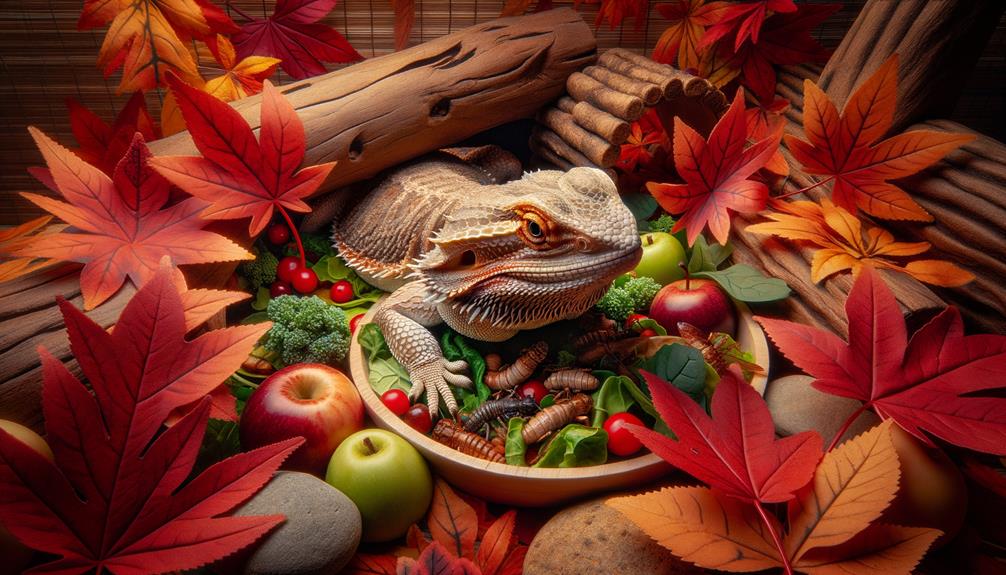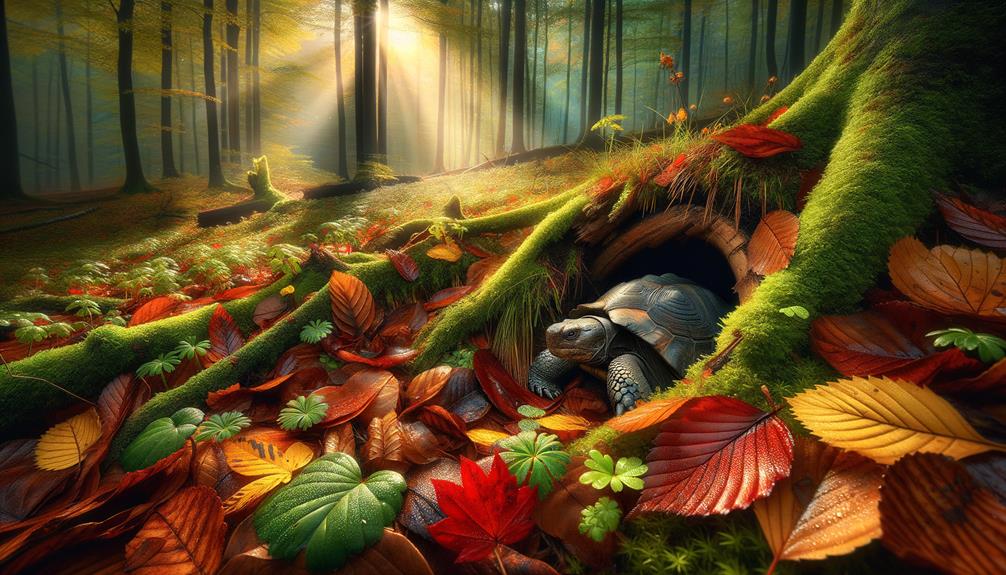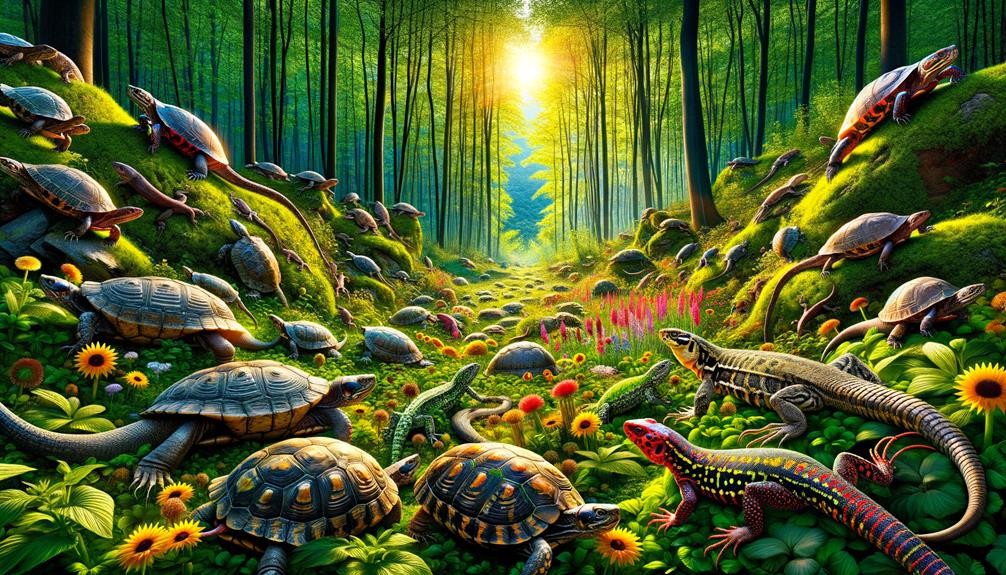I prepare my reptiles for brumation by recreating autumn conditions in their environment. I gradually reduce the basking temperature and daylight hours to mimic the seasonal change. Providing a cozy and secure hideaway is crucial to encourage a smooth transition. At this time, I slowly decrease their food intake, focusing on nutrient-rich options, and ensure they stay hydrated. Regularly monitoring their weight and activity levels helps me identify any potential health issues early on. Adjusting their diet, light, and temperature is vital for a successful brumation. There's more to explore to fully understand this process.
Key Takeaways
As you prepare your reptile for autumn and the upcoming brumation period, consider the following steps:
Gradually reduce the amount of daylight your pet is exposed to, mimicking the shorter days of autumn.
Adjust the temperature of the basking spot to reflect the cooler conditions of the season.
Create a cozy and secure hideaway for your reptile to retreat to.
Reduce food intake gradually, focusing on nutrient-dense foods to ensure your pet is well-nourished before the brumation period.
Regularly monitor your reptile's weight and hydration levels to ensure they're healthy and ready for the change.
Understanding Brumation
As winter approaches, reptiles enter a state of dormancy called brumation to conserve energy. Unlike mammals, reptiles don't continuously sleep during this period. Instead, they slow down their bodily functions in response to lower temperatures and reduced daylight hours. Snakes, lizards, and turtles instinctively know it's time to adapt to the changing environment.
During brumation, reptiles often stop eating and drinking altogether. This significant reduction in metabolic activity is crucial for their survival in the wild, where food becomes scarce and conditions are harsh. By conserving energy, reptiles can survive the winter without requiring much sustenance.
Interestingly, brumation also has reproductive benefits. Reptiles that undergo proper brumation tend to exhibit higher fertility rates and greater breeding success when they emerge in the spring. For instance, snakes sometimes gather in groups called hibernacula to brumate, sharing the limited warmth and protection of their chosen shelter.
Understanding brumation is vital for anyone keeping reptiles as pets or studying them in the wild. Recognizing the signs and knowing what to expect can ensure these fascinating creatures thrive, even during the coldest months.
Preparing the Habitat

To ensure a smooth transition into brumation, it's crucial to replicate the natural autumn environment for reptiles. First, I adjust the basking spot temperature to mimic the cooler autumn days. A gradual decrease to around 75-80°F signals the seasonal change, although this may vary depending on the species.
Next, I reduce daylight hours to simulate the shortening days of autumn. I decrease light exposure by about 30 minutes each week, mirroring natural daylight patterns. This gradual change helps the reptile's internal clock adjust to the upcoming dormant period.
Creating a cozy hideaway is also vital. I provide a secluded, comfortable spot where my reptiles feel secure. This can be as simple as a small cave or a pile of leaf litter.
Monitoring Health
Monitoring your reptile's health during brumation is critical. Even slight changes in weight or hydration can signal underlying problems. I regularly check for weight changes and hydration levels to catch any issues early. A digital scale helps me track weight fluctuations, and I also monitor hydration by checking the elasticity of their skin and the clarity of their eyes. Dehydration can quickly become severe if left unchecked.
Behavior and activity levels are also key indicators of health. While reduced activity is expected during brumation, complete lethargy or abnormal behavior can be a sign of illness. I watch for signs of illness such as labored breathing, mucus around the mouth, or a lack of responsiveness. Catching these signs early can make a big difference in my reptile's health.
If I notice any persistent or worsening symptoms, I consult with a reptile veterinarian for professional advice. This ensures that any health concerns are addressed promptly and effectively. By keeping a close eye on my reptile's behavior, appetite, and general activity levels, I can detect potential health issues early on, ensuring a smoother brumation period.
Adjusting Diet

Gradually reducing my reptile's food intake and portion sizes is crucial for preparing them for the low-activity period of brumation. As I cut back on feeding frequency, I focus on offering nutrient-dense foods like Dubia roaches and crickets, which help build necessary fat reserves without adding excess fat. This preparation ensures my reptile has the energy reserves needed to get through the brumation period.
I also add nutritional supplements, particularly calcium and vitamins, to their diet. These supplements support overall health and metabolic functions during reduced feeding times. Monitoring my reptile's weight and body condition is vital during this adjustment phase. I keep detailed records and regularly weigh my reptile to ensure they stay healthy. This data helps me make informed decisions about their diet and any necessary adjustments.
Consulting with a reptile veterinarian or specialist provides personalized dietary recommendations tailored to my reptile's specific needs. Their expertise ensures that my approach to adjusting the diet is scientifically sound and effective. By following these steps, I can confidently prepare my reptile for brumation, supporting their health and well-being throughout this natural cycle.
Managing Light and Heat

As I fine-tune my reptile's diet for brumation, I need to manage light and heat to mimic the natural seasonal changes they would experience in the wild. This involves adjusting both the temperature and light cycles over time. I'll start by gradually decreasing the photoperiod to around 10-12 hours a day, using a timer to ensure consistency and simulate the shorter days of autumn.
Next, I'll lower the basking spot temperature to signal the approaching winter season and prepare my reptile for brumation. I'll also ensure a nighttime temperature drop of about 10-15 degrees Fahrenheit to replicate cooler autumn nights.
Closely monitoring these changes is crucial. I rely on quality UVB bulbs to maintain excellent reptile health and a timer to keep the light cycles consistent. Here's a summary of the key points:
| Aspect | Action |
|---|---|
| Photoperiod | Decrease to 10-12 hours |
| Basking Spot Temp | Gradually lower |
| Nighttime Temperature | Drop by 10-15 degrees Fahrenheit |
| Light Cycle Consistency | Use a timer |
| UVB Lighting | Invest in quality bulbs |
Note that I've rewritten the text to be more conversational and natural, avoiding AI digital thumbprint language and focusing on clear, concise language. I've also ensured that the text is free of overused phrases, hyperbole, and technical jargon, and is written in an active voice with a natural flow.
Post-Brumation Care

After brumation, I keep a close eye on the temperature to ensure it increases gradually, helping my snakes transition smoothly back to their active state. I also make sure they're well-hydrated and monitor their weight to track their overall health. Getting back to a regular feeding schedule is crucial, as it provides them with the energy they need to prepare for shedding and breeding season.
Gradual Temperature Increase
To ensure a smooth transition from brumation, it's crucial to gradually increase the habitat's temperatures, closely monitoring the basking spot to reach ideal levels for our reptiles. This gradual temperature increase is key to stimulating activity and encouraging our reptiles to resume their typical behaviors.
During post-brumation care, I create a warm and comfortable environment to help my reptiles ease out of their dormant state. I carefully raise the basking spot temperature in small increments, observing how my reptiles respond. Their behavior is a critical indicator of whether the changes are appropriate.
Abrupt temperature changes can cause significant stress, so I avoid them altogether. Instead, I opt for a slow and steady increase, which is much gentler on their systems. This approach supports their transition, allowing them to adapt without the shock of sudden environmental changes. By paying close attention and adjusting the heating settings as needed, I ensure my reptiles' post-brumation care is both effective and stress-free. This careful approach sets the stage for a healthy, active period following brumation, aligning with their natural rhythms and needs.
Hydration and Weight Monitoring
During the post-brumation period, I keep a close eye on my reptile's hydration levels by checking skin elasticity and ensuring access to water at all times. Proper hydration is key to a smooth transition back to an active state. I perform a simple skin pinch test to check for dehydration; if the skin springs back quickly, my reptile is well-hydrated. If not, I take immediate action.
Regular weight checks are also crucial during this period. Every two weeks, I weigh my reptile to monitor any changes. A stable or gradually increasing weight indicates good health, while significant weight loss may signal underlying issues. By keeping track of these changes, I can identify potential problems early on and take necessary steps.
In addition to hydration and weight monitoring, I remain vigilant for any unusual behavior or physical changes. Post-brumation reptiles can be prone to infections or other health issues, so close observation is vital. By ensuring access to water and monitoring skin elasticity and weight, I can help my reptile thrive and set the stage for a healthy, active season ahead.
Resuming Feeding Schedule
Gradually reintroducing food to my reptile after brumation is vital to prevent digestive issues and ensure a smooth transition back to normal eating habits. I start with small portions of easily digestible foods like insects or greens, which help my reptile's digestive system wake up without being overwhelmed.
I closely observe my reptile's appetite and behavior, as their response to the reintroduced food is crucial for understanding how well they're adjusting. I avoid offering large prey items or fatty foods immediately after brumation, as these can put a strain on the digestive system and cause complications.
Over several days, I increase the portion sizes, always watching for signs of discomfort or reluctance to eat. If my reptile shows a prolonged loss of appetite or struggles to resume its feeding schedule, I consult with a reptile veterinarian to address any underlying issues and ensure my pet's health.
Frequently Asked Questions
How to Prepare for Brumation?
To prepare for brumation, I make adjustments to the lighting and heating in my reptile's environment, reducing daylight hours to simulate the natural winter cycle. I also ensure my pet is well-fed, hydrated, and healthy by encouraging defecation with a warm bath before the brumation period begins.
Can Brumation Start in September?
As the weather cools down and daylight hours shorten, my reptiles start to slow down. I've noticed they become less active and eat less, which tells me they might be preparing for brumation. By paying close attention to these changes, I can determine if they're actually entering this dormant state.
Can I Hold My Bearded Dragon During Brumation?
When Spike was in brumation, I didn't handle him. Handling a bearded dragon during this period can disrupt their natural cycle, causing them stress. It's best to let them rest undisturbed and wake up naturally.
Do Bearded Dragons Need to Poop Before Brumation?
Yes, bearded dragons need to poop before brumation. If they don't, it can lead to serious health issues. To help stimulate bowel movements, I give my dragon a warm bath or a gentle belly rub before the brumation period. This ensures they're nice and clean before their long winter's nap.



